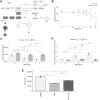Mycophenolate mofetil directly modulates myeloid viability and pro-fibrotic activation of human macrophages
- PMID: 39312626
- PMCID: PMC12048068
- DOI: 10.1093/rheumatology/keae517
Mycophenolate mofetil directly modulates myeloid viability and pro-fibrotic activation of human macrophages
Abstract
Objectives: Mycophenolate mofetil (MMF) is an immunosuppressant used to treat rheumatological diseases, including systemic sclerosis (SSc). While MMF is an established inhibitor of lymphocyte proliferation, recent evidence suggests MMF also mediates effects on other cell types. The goal of this study was to determine the effect of MMF on monocytes and macrophages, which have been implicated in SSc pathogenesis.
Methods: Human monocyte-derived macrophages were cultured with the active MMF metabolite, mycophenolic acid (MPA), and assessed for changes in viability and immuno-phenotype. Guanosine supplementation studies were performed to determine whether MPA-mediated effects were dependent on de novo purine synthesis. The ability of MPA-treated macrophages to induce fibroblast activation was evaluated, and dermal myeloid expression signatures were analysed in MMF-treated SSc patients.
Results: MPA reduced viability and induced apoptosis in monocytes and macrophages at doses (average IC50 = 1.15 µg/ml) within the target serum concentration of MMF-treated SSc patients (1-3 µg/ml). These effects were reversed by guanosine supplementation. Low-dose MPA (0.5 µg/ml) attenuated IL-4 or SSc plasma-mediated macrophage activation, and inhibited the ability of SSc plasma-activated macrophages to induce SSc fibroblast activation. Gene expression studies demonstrated significant reductions in dermal myeloid signatures in MMF-responsive SSc patients.
Conclusion: For the first time, we have demonstrated that MMF inhibits the viability and pro-fibrotic activation of human monocytes and macrophages, which is dependent on de novo purine synthesis. Coupled with myeloid gene expression attenuation following MMF treatment in patients, these results suggest that the fibrotic inhibition observed with MMF may be attributable, at least in part, to direct effects on myeloid cells.
Keywords: fibrosis; inflammation; macrophages; mycophenolate mofetil; systemic sclerosis.
© The Author(s) 2024. Published by Oxford University Press on behalf of the British Society for Rheumatology. All rights reserved. For commercial re-use, please contact reprints@oup.com for reprints and translation rights for reprints. All other permissions can be obtained through our RightsLink service via the Permissions link on the article page on our site—for further information please contact journals.permissions@oup.com.
Figures





References
-
- Allison AC, Eugui EM. Mycophenolate mofetil and its mechanisms of action. Immunopharmacology 2000;47:85–118. - PubMed
-
- Bernstein EJ, Huggins JT, Hummers LK, Owens GM. EBSCOhost | 157543047 | systemic sclerosis with associated interstitial lung disease: management considerations and future directions. Am J Manag Care 2021;27:S138–46. - PubMed
-
- Mehling A, Grabbe S, Voskort M et al. Mycophenolate mofetil impairs the maturation and function of murine dendritic cells. J Immunol 2000;165:2374–81. - PubMed
-
- Allison AC, Eugui EM. Mechanisms of action of mycophenolate mofetil in preventing acute and chronic allograft rejection. Transplantation 2005;80:S181–90. - PubMed
MeSH terms
Substances
Grants and funding
LinkOut - more resources
Full Text Sources
Medical

